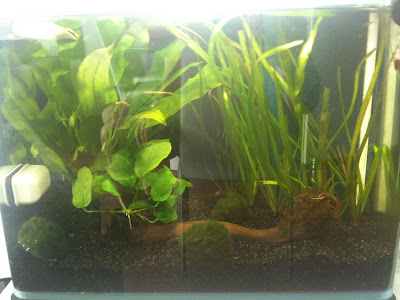DIY Gravel Cleaner
The nano aquarium is up and running for a few weeks now. It was only running for a week until I realised I needed a gravel cleaner. Why? Because I need to take water out of the tank for a weekly refresh, I want to clean the gravel, but I don't want to suck it up with the hose!!!
I soon found out there are specialised articles on the market for these types of tanks, but also that they are well overpriced. I decided to use some of the leftovers to build a DIY Gravel Cleaner after the idea of JBL, found here. (Nice thing about it is that it is square so it can reach the corners of the tank easily)
Here are the steps I took:
- Take some PVC, e.g. electrical pipe, some tubing of roughly the same diameter and make sure to have some tie-wraps and teflon-tape or plumbers-tape ready
- Take a small (transparent) square container left over after the contents have run out. I used a soap-container in my example. I would not recommend to use something that stored any more serious chemicals
- Clean out the container REALLY thoroughly as shrimps will die if you don't!!!
- Cut out the bottom of the container with a stanley knife
- Bend the PVC pipe in a 90 degree angle to form an L-shape, such that it feeds the hose away from the tank
- Insert the PVC pipe into the fill-cap of the container. If it doesn't fit, use the plumbers-tape to create a tight fit and secure it with a tie-wrap
- Fit the hose over the other end of the PVC tube by heating it in hot water, lubricating it with some soap and stretching it over the PVC pipe. Cool it down in order to quickly shrink it and secure it with a tie-wrap
- Do some cleaning again to make sure any leftovers of soap are gone!
Your end-result, with all freedom for own interpretations in sizes and shapes, may look something like this:
Usage:
Obviously, this tool is used to take water out of the tank, have enough suction power to take away dirt while keeping the gravel in the tank. Here is a quick how to:
- Place a bucket on the floor near the tank
- Put the gravel cleaner in the tank (make sure there are no curious shrimps in it)
- Suck up some water from the other side of the hose (don't worry, you won't die of a little water and you will get better at it)
- Now quickly put that end of the hose in the bucket when pressure builds up
- If you have a large diameter hose, like I do, squeeze it to control the flow and keep the gravel inside the tank
- To stop the flow, just pull the cleaner out of the aquarium
Tips:
- I actually use the same hose, but in reverse, for filling the aquarium
- The larger the difference in heights between the bucket and the tank, the higher the flow-rate
Have fun using this cheap solution to great aquarium cleaning!







